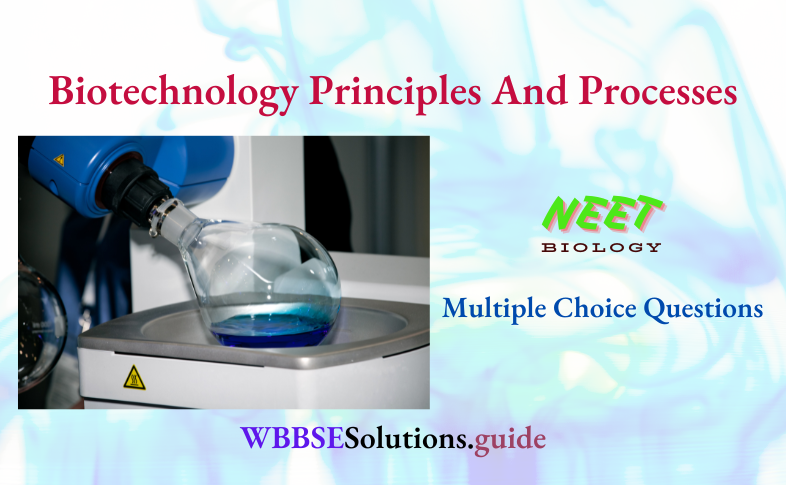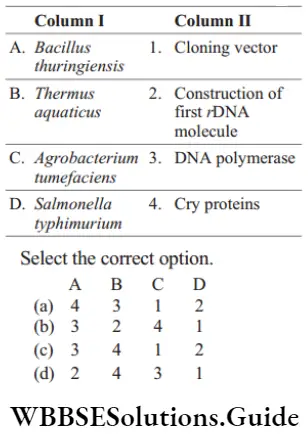Biotechnology Principles And Processes Miscellaneous
Question 1. The RTF region enables the plasmid to
- Be transmitted to other bacteria by conjugation
- Undergo transformation
- Replicate in the host cell
- Code for enzymes that inactivate specific drugs
Answer: 1. Be transmitted to other bacteria by conjugation
Read And Learn More: NEET Biology Multiple Choice Question And Answers
- Resistance or R plasmid is a circular DNA that consists of genes that make the bacterium antibiotic-resistant. Such a plasmid consists of two segments of DNA, one is responsible for replication as well as the transfer of R.
- Plasmid and the second have the genes that produce substances neutralizing the action of one or another antibiotic or other drugs. These plasmids are conjugative and spread among the bacteria through conjugation.
NEET Biology Mcq Chapter Wise
Question 2. Which one of the following is a case of incorrect matching?
- Somatic hybridization – a fusion of two diverse cells
- Vector dna – site for tRNA synthesis
- Micropropagation– in vitro production of plants in large numbers
- Callus – an unorganized mass of cells produced in tissue culture
Answer: 2. Vector dna – site for tRNA synthesis
“biotechnology principles and processes “
- (2) Option (2) is incorrect matching and can be corrected as vectors are dna molecules that can carry a foreign dna segment and replicate inside the host cell.
- They are used in recombinant dna technology because it is harmless and can be easily cultured. Rest all options are correct matchings.
Question 3. Paleontologists unearthed a human skull during excavation. A small fragment of the scalp tissue was still attached to it. Only a little dna could be extracted from it. If the genes of ancient man need to be analyzed, the best way of getting a sufficient amount of dna from this extract is
- By hybridizing the dna with a dna probe
- By subjecting the dna to a polymerase chain reaction
- By subjecting the dna to gel electrophoresis
- By treating the dna with restriction endonucleases
Answer: 2. By subjecting the dna to polymerase chain reaction
The polymerase chain reaction (PCR) is a technique by which small samples of dna can be quickly amplified. Starting with only one gene-sized piece of dna, this technique is used to make billions of copies in only a few hours.
“plasmid has been used as vector because “
Question 4. Escherichia coli is an important material for genetic experiments because
- It is harmless
- It is haploid
- It can be easily cultured
- Both (1) and (3)
Answer: 4. Both (1) and (3)
Of all the model organisms and tools for genetic modification available, e. Coli stands out as a model organism. It is harmless and can be easily cultured. Thus, option (4) is correct.
NEET Biology Mcq Chapter Wise

NEET Biology Biotechnology Principles and Processes MCQs with Answers
Question 5. In vitro, clonal propagation in plants is characterized by
- Pcr and rapid
- Northern blotting
- Electrophoresis and HPLC
- Microscopy
Answer: 1. Pcr and rapid
- Clonal propagation represents the technique in which vegetative tissue is used to produce plants that are genetically identical to their parents. It can be characterized by PCR and rapid.
- The polymerase chain reaction (PCR) technique, generates microgram (mg) quantities of dna copies (up to billion copies) of the desired dna or RNA segment, present even as a single copy in the initial preparation, in a matter of few hours.
- Rapid stands for random amplification of polymorphic dna. It is a type of PCR, but the segments of dna that are amplified are random.
Question 6. The frequency of recombination is
- Same for all genes
- Highest for genes that first entered the recipient cells
- Lowest for genes that first entered the recipient cells
- None of the above
Answer: 2. Highest for genes that first entered the recipient cells
- The frequency of recombinants determines the order of entry for each gene. During the process of conjugation, the genes are transferred through the conjugation tube. Spontaneous breakage of this tube creates a natural gradient of transfer.
- There are fewer chances that the latter genes will be received by the bacterial cell. The gene which enters the first in the cell has the maximum frequency of recombination as compared to those genes which enter later.
“biotechnology principles and processes class 12 “
Question 7. Prophage comprises
- Viral dna attached to host dna
- Viral dna found in a host
- Dna and protein particles in the host
- Naked viral dna
Answer: 1. Viral dna attached to host dna
- A provirus is a virus genome that is integrated into the dna of the host cell. In the case of bacterial viruses (bacteriophages), proviruses are often referred to as prophages.
- Reverse transcription of retroviral genomic RNA yields double-stranded dna that is integrated into the host genome to form a provirus.
NEET Biology rDNA Technology and Gene Cloning MCQs
Question 8. How many recombinant therapeutics have been used for human diseases throughout the world?
- 12
- 24
- 30
- 56
Answer: 3. 30
Recombinant therapeutics refer to specialized medicines made up of recombinant protein. The production of recombinant therapeutics is possible only due to recombinant dna technology. At present 30 recombinant therapeutics have been approved for the use of humans around the world.
Question 9. In addition to the taq polymerase enzyme which other thermostable dna polymerases have been isolated to be used in a polymerase chain reaction (PCR)?
- Vent polymerase
- Pfu polymerase
- Both (1) and (2)
- None of these
Answer: 3. Both (1) and (2)
- Pfu polymerase and tli polymerase (vent), which are both thermostable have been isolated in addition to taq dna polymerase. Pfu polymerase is isolated from micrococcus furiosus and pneumococcus litoralis provides tli (vent) polymerase.
- The use of thermostable taq allows the PCR to operate at high temperatures, thereby promoting the high specificity of the primers and reducing the output of non-specific products, such as primer dimers. Thus, option (3) is correct.
NEET Biology Mcq Chapter Wise
Question 10. Retroviruses have genetic material which is
- Dna
- Rna
- Both and
- Proteins
Answer: 2. Rna
Retroviruses have RNA as their core nucleic acid, e.g. Rous sarcoma virus, avian leukemia virus, and the virus-causing aids (half – 3). In retroviruses, transcription can take place in the reverse direction, i.e. From rna to dna
“principles and processes of biotechnology “
Question 11. Restriction endonuclease requires which of the following ions for cleavage?
- Na +
- Mg 2+
- K+
- H +
Answer: 2. Mg 2+
- Restriction endonucleases as well as many other enzymes that act on phosphate-containing substrate require mg 2+ or some other similar divalent cation for activity.
- Additional studies proved that a second magnesium ion must be present in an adjacent site for eco rv endonuclease to cleave its substrate.
Important MCQs on Biotechnology Principles and Processes for NEET
Question 12. Choose the correct pair from the following.
- Polymerases – break the dna into fragments
- Nucleases – separate the two strands of dna
- Exonucleases– make cuts at specific positions within dna
- Ligases– join the two dna molecules
Answer: 4. Ligases– join the two dna molecules
Tools and Techniques in Biotechnology MCQs for NEET
Question 13. Match the organism with its use in biotechnology.

Answer: 2. A-4, b-3, c-1, d-2.
